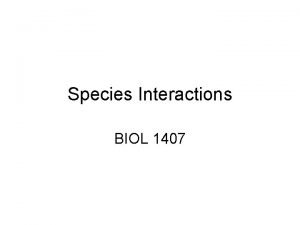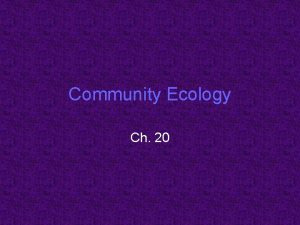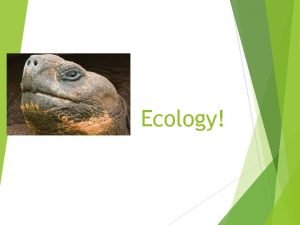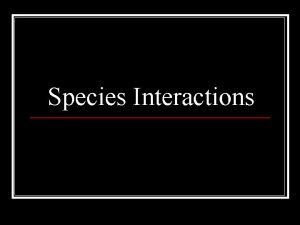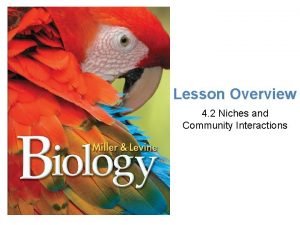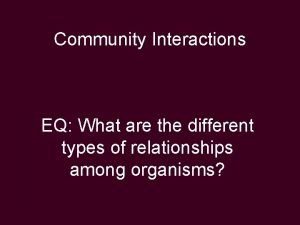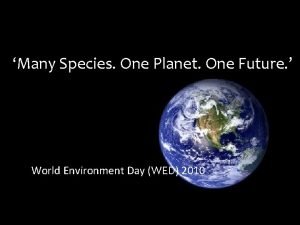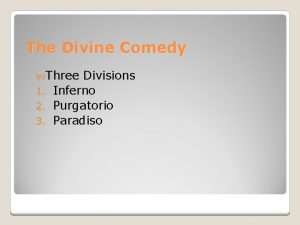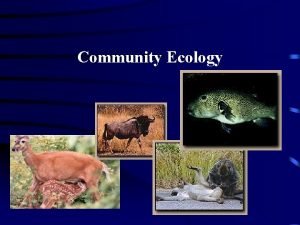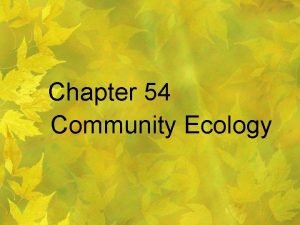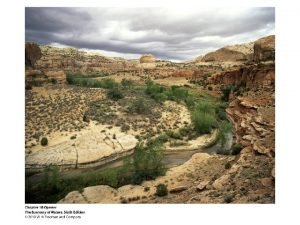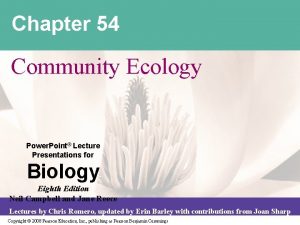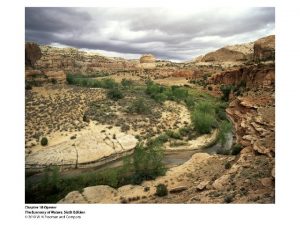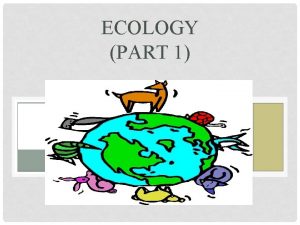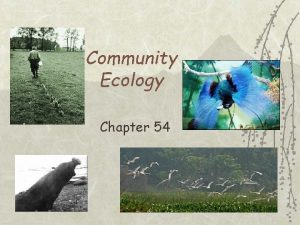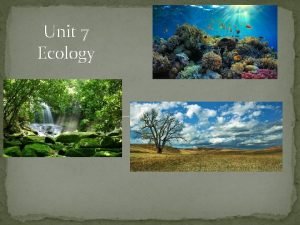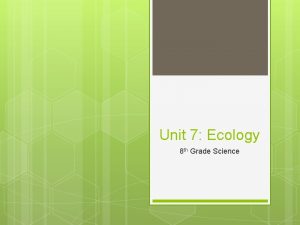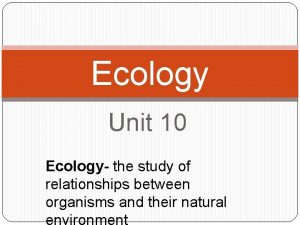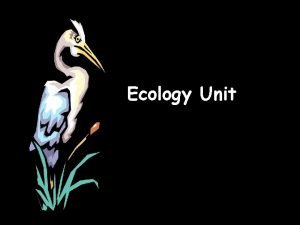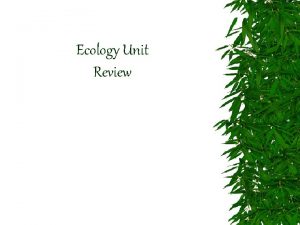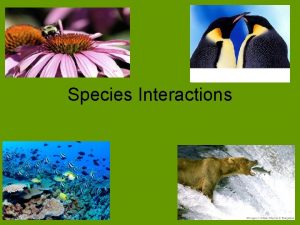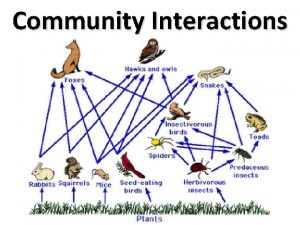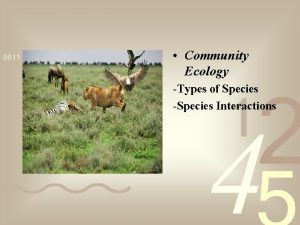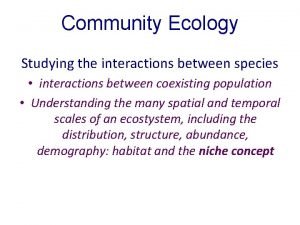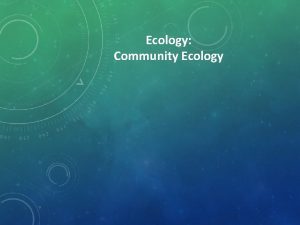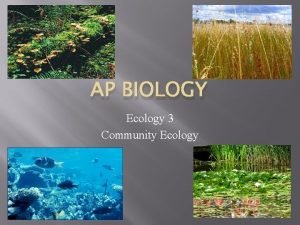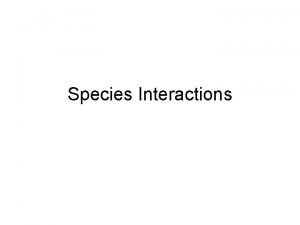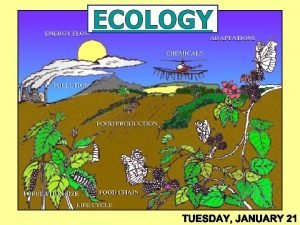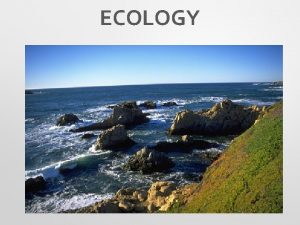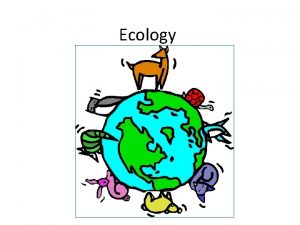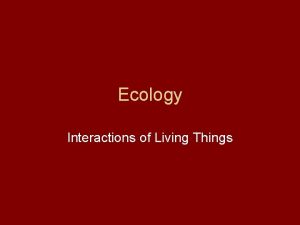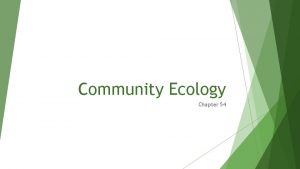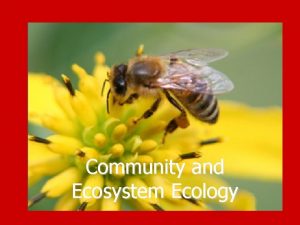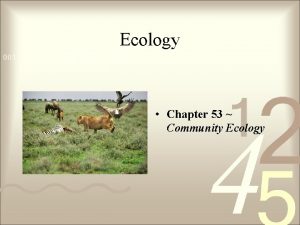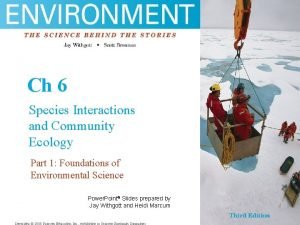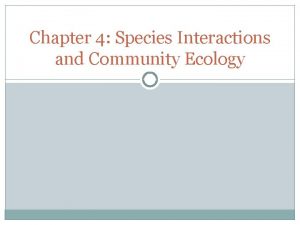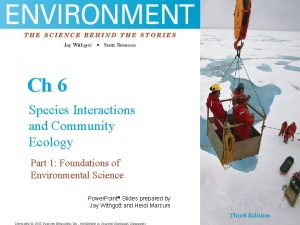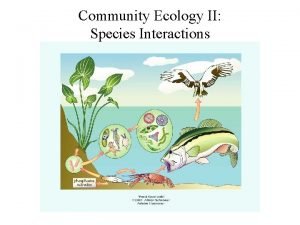Unit One Species Interactions Community Ecology Divisions of















































- Slides: 47

Unit One “Species Interactions & Community Ecology”

Divisions of Biology n Biology, the study of life, can be subdivided into several sub disciplines: n Ecology – study of the interactions between _abiotic and biotic factors in an area Landscape Ecology n Behavioral Ecology n Population Ecology n Conservation Biology n Conservation Genetics n

Divisions of Biology cont’d n Zoology – study of fauna Herpetology – study of amphibians and reptiles n Ornithology – study of birds n Mammalogy – study of mammals n Entomology – study of insects n Ichthyology – study of fish n n Botany - study of flora

Divisions of Biology cont’d Marine Biology – study of salt water flora and fauna n Limnology – study of fresh water ecosystems n *** The bottom line: there are many subdivisions of biology that all focus on a specific topic within that discipline (all the previously mentioned are at the macro level i. e. visible to the naked eye)

Species Interactions n n Competition – the interactions that occur between various individuals while attempting to obtain the same resource (food, water, mates etc. ) Two types: n n Intraspecific - occurs between individuals of the same species Interspecific – occurs between individuals of different species; less common of the two types

Species Interactions cont’d n n Recall that a “niche” is the species role in its habitat There are two types: n n Fundamental niche – theoretical niche of species Realized niche – actual niche of species If a species has a very specific niche it is called a specialist ex: Limpkin If a species has a very broad niche it is a generalist ex: Black Bear

Species Interactions cont’d n Symbiotic Relationships – a relationship between two individuals of different species Species One Mutualism + Parasitism + Commensalism + Predator/Prey + Competition - Species Two + 0 -

Ecological Communities n n n Organisms must have energy to survive Many species synthesize food to then break down that food into energy through a process called Photosynthesis Those organisms that generate their own energy are called plants = producers, autotrophs, and flora

Ecological Communities cont’d n n Organisms that cannot “make” their own food and hence must eat other living things to get energy are called consumers, heterotrophs, fauna, and animals Those species that must consume others to get energy are divided into categories based on what they eat

Ecological Communities cont’d n The four categories of consumers are as follows: Herbivores – eat plants n Carnivores – eat meat n Omnivores – eat both plants and meat n Decomposers – eat dead animal matter/animal byproducts n

Ecological Communities cont’d n n n The food consumers digest is converted into energy which is used by all cells in their bodies A food chain shows how energy moves through an ecosystem; each stage in the hierarchy of the chain is called a trophic level Producers are always at the bottom of a food chain/ they always anchor the other trophic levels


Ecological Communities cont’d n A food web shows all the possible feeding relationships in an ecosystem, and it also shows how energy moves through the system

Ecological Communities cont’d n Keystone Species – a species in an ecosystem that other species benefit from and/or depend on for survival n Ex: Gopher Tortoise

Ecological Communities cont’d n n n Ecosystems develop through a process called succession Ecosystems are not static, but rather are dynamic i. e. they are always changing There are three stages of succession 1. Primary succession n 2. Secondary succession n 3. Climax community n

Ecological Communities cont’d n Pioneer species such as lichens are required in order for primary succession to occur, and hence get the process of succession started

Ecological Communities cont’d n n Ecosystems are adversely affected by a variety of outside forces There are four main reasons for species and ecosystem decline: 1. habitat destruction/habitat fragmentation n 2. pollution n 3. overexploitation n 4. exotic/non-native species n

Ecological Communities cont’d n Habitat restoration and species reintroduction programs are ways to mitigate the negative impacts humans have on ecosystems and their inhabitants Ex: Everglades Restoration Wolf reintroduction into Yellowstone Nat’l Park

Earth’s Biomes n n n A biome is a large area with similar vegetative associations as the result of similar climatic characteristics; many ecosystems are contained within one biome The two most important climatic characteristics that determine the various biomes are temperature and precipitation Florida is a part of the temperate deciduous forest biome

Biomes of the World

Unit One “Biology Basics” “Environmental Systems: Chemistry, Energy, & Ecosystem”

Earth’s Environmental System n n n Recall that ecologists study the interaction between abiotic and biotic factors in an ecosystem Ecosystems, if healthy, are in a state of dynamic equilibrium i. e. they are always undergoing some type of fluctuation in number of individuals of a species or nutrient content Dynamic equilibrium relates directly to the concept of a feedback loop

Earth’s Environmental System cont’d n n All ecosystems are open systems in that energy and matter are exchanged between them The Earth can be divided into parts: n n Lithosphere – rock and sediment on the various land masses Atmosphere – gases surrounding the planet Hydrosphere – the water on the Earth Biosphere – all parts of the Earth that support life

Earth’s Environmental System cont’d n n n Landscape Ecologists study broad areas and attempt to learn more about the gradual changes in vegetative associations that occur over hundreds of kilometers While traditional ecologists focus their attention on ecosystems, landscape ecologists study many ecosystems at once While conducting research, both ecologists and landscape ecologists study ecotones, transition areas between two ecosystems/biomes where plants from both ecosystems/biomes are found

Ecotone

Earth’s Environmental System cont’d n n As stated previously, producers a. k. a. flora, plants, and autotrophs, are always at the bottom of the food chain because all other living organisms depend directly or indirectly on them Producers carry out photosynthesis which supplies their cells with energy to maintain themselves and extra energy to grow

Earth’s Environmental System cont’d n n n The overall production of energy by producers is called gross primary production The extra energy that producers use to grow that is in addition to the energy needed to maintain cells is called net primary production Biomes such as desert, tundra, and open ocean have low net primary productivity

Biogeochemical Cycles n n n The availability of nutrients in addition to ample amounts of sunlight and water determine what areas of the Earth have high net primary productivity In other words, it is not just water and sunlight that are important for plant growth Nutrients such as carbon , nitrogen, and phosphorus are needed for substantial plant growth

Carbon Cycle

Carbon Cycle n https: //www. youtube. com/watch? v=nz. Im o 8 k. SXi. U

Nitrogen Cycle

Nitrogen Cycle n https: //www. youtube. com/watch? v=oy 8 e 2 Hr. Oh 6 Q

Phosphorus Cycle

Phosphorus Cycle n https: //www. youtube. com/watch? v=RKk. C 2 Jpja. Gc

Hydrologic Cycle

Geological Systems: How Earth Works n n n The rock cycle is also very important to the existence of life Recall the rock cycle is directly involved in the recycling of phosphorus Plants have to attach themselves to some type of substrate in order to survive; they cannot live freely in the air Most plants grow out of soil A few plants can live directly on top of rock - pioneer species Additionally, a few plants called epiphytes live off the ground attached to the bark of trees

Geological Systems: How Earth Works cont’d n n The rock cycle is defined as the means by which rock is formed, changed, and reformed by heat, pressure, and time Rock is divided into three categories based on how it is formed and its chemical composition n Igneous – heat is required Metamorphic - heat and pressure are required Sedimentary - pressure is required

Geological Systems: How Earth Works cont’d n The majority of the fossil record used to construct the Geologic Time Scale and additionally support theory of evolution is found in sedimentary rock. . . why?

Unit One “Biology Basics” “Biodiversity and Conservation Biology”

What is Biodiversity n n Recall, biodiversity is the variety of life whether one focuses on the Earth as a whole, a somewhat smaller area known as a biome, or an even smaller area called an ecosystem There are 3 levels of biodiversity which are from smallest to largest: n n n 1. genetic diversity 2. species diversity 3. ecosystem diversity

What is Biodiversity cont’d n n n Recall that biodiversity tends to be highest in areas with moderate climatic conditions Rainforests and coral reefs are two biomes that have high biodiversity Recall, areas with high biodiversity are called hot spots

Threats to Biodiversity n n Humans are the primary cause for loss of biodiversity during the last few hundred years As stated previously, the four main anthropogenic (human related) reason for species decline are: n n 1. habitat destruction/habitat fragmentation 2. pollution 3. overexploitation 4. exotic species


Benefits to Preserving Biodiversity n There are several benefits to preserving biodiversity 1. medicinal value of flora n 2. improved food crops n 3. maintains ecosystem function n 4. economic benefits - tourism and recreation n 5. overall aesthetic value n

What is Conservation Biology n n This discipline of Conservation Biology is relatively new (1980’s) and focuses on the preservation/restoration of biodiversity at the three levels (genetic, species, and ecosystem) It is a response to the documented loss of species over the last few hundred years

What is Conservation Biology cont’d n n n Conservation biologists are able to affect change because of the federal endangered species act of 1973 If a species is “listed”, it then garners special protection under the above act There can be three “listed” categories: n n n 1. species of special concern 2. threatened 3. endangered

What is Conservation Biology cont’d n n Once a species is “listed” no one is permitted to negatively impact individuals of that species or their surrounding habitat Conservation biologists participate in many initiatives to help a species increase in number n n n 1. captive breeding 2. habitat restoration 3. creation of corridors 4. reintroduction programs 5. general research
 5 types of symbiosis
5 types of symbiosis Interspecific competition definition
Interspecific competition definition Section 20-1 review species interactions
Section 20-1 review species interactions 6.1 niches and community interactions answers
6.1 niches and community interactions answers Symbiosis and species interactions keystone webquest
Symbiosis and species interactions keystone webquest 5 major types of species interactions
5 major types of species interactions One vision one identity one community
One vision one identity one community Asean one vision one identity one community
Asean one vision one identity one community Keystone predators
Keystone predators Niches and community interactions
Niches and community interactions 3 types of community interactions
3 types of community interactions One futureworld
One futureworld 3 divisions of comedy
3 divisions of comedy Define keystone species in biology
Define keystone species in biology 52
52 Ecosystem vs community
Ecosystem vs community Community ecology
Community ecology Chapter 3 section 1: community ecology answer key
Chapter 3 section 1: community ecology answer key Chapter 54: community ecology answer key
Chapter 54: community ecology answer key Evolution and community ecology guided notes
Evolution and community ecology guided notes Definition of community ecology
Definition of community ecology Chapter 54 community ecology
Chapter 54 community ecology Chapter 5 evolution and community ecology
Chapter 5 evolution and community ecology Chapter 5 evolution and community ecology answer key
Chapter 5 evolution and community ecology answer key The definition of community
The definition of community An organisms rank in a feeding hierarchy
An organisms rank in a feeding hierarchy Ecology part 1
Ecology part 1 Chapter 54 community ecology
Chapter 54 community ecology Unit 7 ecology
Unit 7 ecology Unit 7 ecology answer key
Unit 7 ecology answer key Which of the following tells you population density
Which of the following tells you population density Unit 10 ecology
Unit 10 ecology Ecology unit review
Ecology unit review Sulfur oxide
Sulfur oxide One empire one god one emperor
One empire one god one emperor One one one little puppy run
One one one little puppy run One king one law one faith
One king one law one faith One empire one god one emperor
One empire one god one emperor Ford one plan
Ford one plan See one do one teach one
See one do one teach one One price policy
One price policy Willow cabin speech
Willow cabin speech See one do one teach one
See one do one teach one Unit one lesson one
Unit one lesson one Lesson 1 english
Lesson 1 english Unit 6 review questions
Unit 6 review questions Unilever home and personal care
Unilever home and personal care Chapter 13 the respiratory system
Chapter 13 the respiratory system

